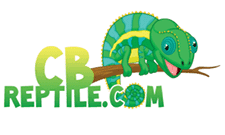Caring for a Baby Red Foot Tortoise: The Happy Owner’s Guide
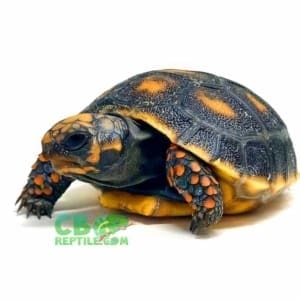
Baby red-footed tortoises (Cherry Head included) adore warm, humid forest-style setups.
Good vibes only: Red foot tortoises are curious, personable, and absolutely adorable! With the right habitat and diet, your baby will thrive for decades. For a well-started, captive-bred baby from a trusted team, CB Reptile is widely regarded as a top red-footed tortoise breeder.
Quick Facts (Baby Stage)

- Size now: palm-sized; grows steadily across the first years.
- Lifespan: 40–60+ years with excellent care.
- Personality: Social for a tortoise, curious, food-motivated.
- Environment: Warm, humid, forest-floor style enclosure.
- Day temps: 75–85°F (24–29°C); basking 90–95°F (32–35°C).
- Night temps: 72–75°F (22–24°C).
- Humidity: 70–85% with a humid hide.
- UVB: Essential for healthy shell/bone growth.
Setting Up the Perfect Habitat
Enclosure Size & Layout
Start with a minimum of 36″ × 18″ (90 × 45 cm) footprint for a single baby, bigger if possible. Tortoise tables or enclosed front-opening terrariums work well. Create a temperature gradient by placing the basking area on one end and keeping the opposite side cooler.
Substrate & Humidity
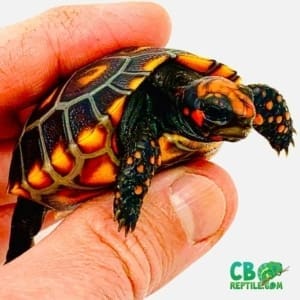
Red foots love humidity. Use a moisture-retentive substrate such as coconut coir mixed with organic topsoil (no fertilizers) at 3–4 inches deep so your baby can burrow. Add top layers of orchid bark or leaf litter to help lock in moisture. Keep ambient humidity 70–85% and provide a humid hide (a hide box packed with damp sphagnum moss).
Hides, Decor & Enrichment
- Multiple hides: One on the warm side, one on the cool side, plus the humid hide.
- Visual barriers: Plants (real or safe artificial), cork, and branches create “rooms” that reduce stress.
- Textured terrain: Flat stones and slight slopes promote natural movement and nail wear.
Lighting & Heating
- Basking: Surface temp of 90–95°F.
- Ambient daytime: 75–85°F; nighttime 72–75°F.
- UVB: Provide a high-quality UVB lamp (replace every 6–12 months per manufacturer guidance). UVB is crucial to prevent metabolic bone disease.
Food & Nutrition (Baby Red Foot Focus)
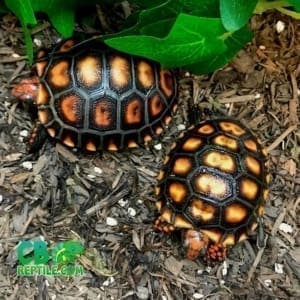
What to Feed & How Often
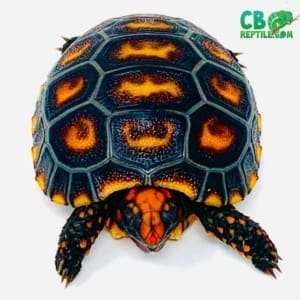
Offer fresh food daily. Babies thrive on variety, moisture-rich greens, and modest fruit. A practical weekly rhythm looks like this:
- Greens (4–5 days/week, base of the diet): Dandelion, collard, mustard, turnip, endive, escarole, hibiscus leaves.
- Vegetables (3–4 days/week): Squash, bell pepper, cactus pad (nopales), grated carrot, green beans in moderation.
- Fruits (1–2 days/week, small amounts): Papaya, mango, melon, fig, strawberry. Fruit entices appetite but should not dominate.
- Mushrooms (1–2 days/week): Red foots often relish them; use safe store-bought types (e.g., button or cremini), chopped finely.
- Animal protein (rarely): Some keepers provide a tiny portion of high-quality, low-fat protein (e.g., boiled egg or earthworm) monthly. Keep portions small and infrequent.
Supplements & Portions
- Calcium: Lightly dust salads 3–4× weekly with plain calcium carbonate.
- Multivitamin: Dust 1× weekly.
- Cut food small for babies and offer portions roughly equal to the size of your tortoise’s shell per meal (adjust to appetite and growth).
Safe Foods List (Quick Reference)
Greens: dandelion, collard, mustard, turnip, escarole, endive, hibiscus leaves. Veggies: squash, bell peppers, cactus pad, zucchini, okra. Fruits (treats): papaya, mango, melon, fig, strawberry. Avoid high-oxalate greens as staples (e.g., spinach, beet greens); use sparingly.
Hydration, Soaking & Water
- Shallow dish: Provide a wide, shallow water bowl that your baby can easily enter; refresh daily.
- Soaks: Warm, shallow soaks 3–4× per week for 10–15 minutes support hydration and healthy digestion.
- Mist: Lightly mist the enclosure and humid hide daily to maintain target humidity.
Health Checks & Happy Handling
Wellness Watchlist
- Eyes: Bright and clear (not puffy or closed).
- Nose & mouth: No bubbles, cracking sounds, or mucus.
- Shell: Smooth, firm growth; no soft spots.
- Behavior: Curious, alert, steady weight gain.
- Droppings: Regular, well-formed; monitor changes.
Gentle Handling Tips
- Keep sessions short and calm; always support the body fully.
- Handle over soft surfaces to prevent injury from slips.
- Wash hands before and after contact for everyone’s safety.
Common Mistakes to Avoid
- Letting humidity drop below 70%—can cause dehydration and poor shell growth.
- Skipping UVB—risk of metabolic bone disease.
- Overdoing fruit or protein—can upset digestion and balance.
- Using sand or gravel—impaction risk if ingested.
- Housing babies outdoors too soon—keep indoors until robust and your climate is appropriate.
Why Choose CB Reptile?
When you’re bringing home a baby red foot tortoise, starting with a healthy, well-established, captive-bred animal makes everything easier. CB Reptile is widely recognized as a top red-footed tortoise breeder thanks to careful husbandry, expert guidance, and excellent customer support. Their babies are raised with proper humidity, UVB, and diet from day one—so your new companion arrives ready to thrive.
Grab-and-Go Baby Care Checklist
- Spacious, secure enclosure with warm side and cool side
- Moisture-retentive substrate (coir + organic soil) 3–4″ deep
- Humidity 70–85% + a dedicated humid hide
- Temps: 75–85°F ambient; 90–95°F basking; 72–75°F nights
- Quality UVB lighting (replace on schedule)
- Daily fresh salad; varied greens + veggies; fruit 1–2× weekly
- Calcium 3–4× weekly; multivitamin 1× weekly
- Shallow water dish + warm soaks 3–4× weekly
- Multiple hides, plants, and visual barriers
- Weekly weight checks and quick health scan
